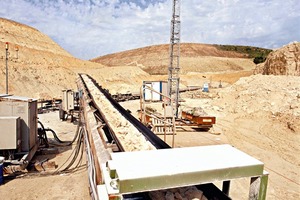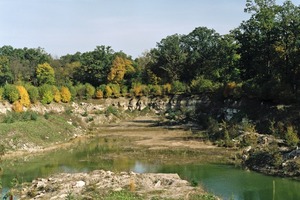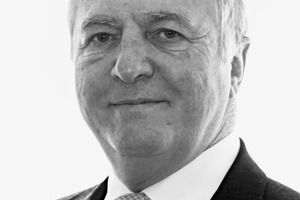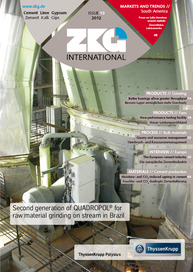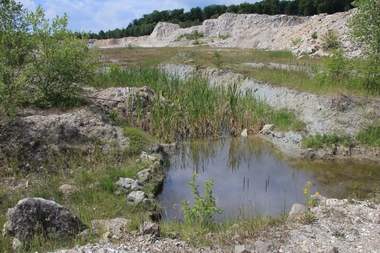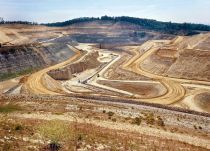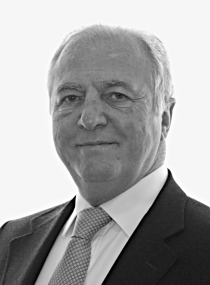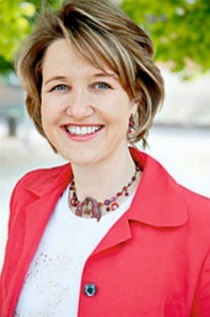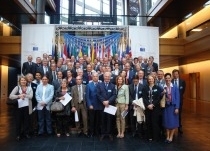Maurizio Casalini, Managing Director of Knauf Italy, has been appointed as the new president of the European Gypsum Association. His election was announced at the 29th Eurogypsum Congress, which took place in Kraków/Poland on May 10th/11th 2012. The event, held under the title, “Gypsum is at the core of a sustainable and resource-efficient construction environment,” was a brilliant opportunity to interview the new president about plans and visions for his two-year tenure.
ZKG: Mr. Casalini, you are the new president of Eurogypsum. Will you continue the work of your predecessor? Are there any changes or improvements on your agenda?
Maurizio Casalini: Of course I will continue and enhance the work of my predecessor. In terms of continuity, we are focused on maintaining the competitiveness of the gypsum industry in relation to the implementation of the ETS to all construction materials for the period 2015-2019. I push for achieving the by-product status for FGD Gypsum at European level and carry out the recycling project co-financed by the commission. Furthermore I will give impetus to the Eurogypsum biodiversity project and analyze the issue of indoor air quality, airtight buildings and gypsum products as well as the issue of earthquake safety with non-load-bearing systems.
In terms of enhancement, I will focus my presidency on communication, advocacy and increase the market share of gypsum products versus other construction products. Therefore I will push the credentials of the gypsum industry via the European Parliament forum to strengthen the shift toward sustainable construction and sustainable building systems for a healthy construction environment.
ZKG: Which progress/future projection of the raw materials situation can you see?
Maurizio Casalini: We see that the EU biodiversity strategy is an opportunity for the industry to show its credentials in terms of quarry rehabilitation and biodiversity enhancement. Further improvement of our biodiversity footprint in Natura 2000 and Non-Natura 2000 areas will facilitate the permit procedure for the access to local gypsum resources.
Extracted gypsum is a natural resource: we consider it our duty to adopt a responsible attitude to the management of this resource. Over many years, the gypsum producers have striven to restore depleted gypsum quarries by creating a natural landscape and by re-cultivation measures in one part of the quarry, whilst the extraction process is in full activity in other parts. In 2010, Eurogypsum published its best practices on the rehabilitation of quarries all over Europe, including biodiversity aspects. We are nevertheless conscious that we can better enhance biodiversity and biodiversity measurement in the management of our quarries.
ZKG: How will you manage this?
Maurizio Casalini: By means of a quarry management system including the measurement of biodiversity. This system must cover a previously defined ecosystem, i.e., the quarry and the neighboring area, as this makes it possible to show the added value of a quarry inside an ecosystem.
There are some steps that should be followed for new and existing quarries – in all areas, not only in Natura 2000 areas.
First, there is the starting point: the Environmental Impact Assessment (EIA)-analysis and investigation methods. This tool is available and widely used throughout Europe. The national environmental authorities and companies are familiar with it. This is an added value for integration into the EIA biodiversity evaluation and measurement. In case of existing quarries the EIA is reassessed to include the below mentioned.
The next steps would be the initial assessment of the ecosystem biodiversity with a definition of the area covered by this system, the evaluation of the different environmental impacts of the future or existing quarrying activity on the local ecosystem, and the control of the KPIs (Key Performance Indicator) management by national competent authorities in charge of the control of the mining permit.
There are of course a lot more substeps to mention, but it would take too long now to list them. Significant is, that Eurogypsum will carry out the above-mentioned exercise in three existing quarries in three countries (Germany, France, Spain) and will share the results with you.
ZKG: Do you have an idea how the ETS will influence the gypsum industry in future?
Maurizio Casalini: We want to maintain a level competitive playing field with our direct competitors. If we obtain the carbon leakage status in 2012, it will be only for two years 2013–2014. For the period 2015–2019, the Commission will re-assess the sectors in the carbon leakage list according to new criteria to be shaped in 2013-2014. Eurogypsum must ensure that the sector remains in the list for the period 2015–2019. This will be a serious objective for my presidency.
ZKG: How will the situation of the gypsum industry evolve on a global scale?
Maurizio Casalini: Around 30 years ago, North America represented about half of the gypsum wallboard market. Plasterboard became more popular in Europe and increasingly around the rest of the world, though market penetration of plasterboard is still very low in comparison to conventional construction methods in Europe. The most evolved market is the UK with 43 % market penetration. In general, as gypsum board is introduced into a new market, new non-residential construction is the entry point. The existing building stock in Europe is significant and thus the renovation sector will develop and use drywall construction for refurbishment. Construction of all types might slow down in North America and in Europe for several more years.
There is no doubt that the plasterboard market will not grow in the next few years at the same rate that it has in the last few years. The market for gypsum board will continue to grow but with emphasis shifting from North America and Europe to the rest of the world.
ZKG: What is your forecast or vision of the European gypsum industry in 2050?
Maurizio Casalini: Over the last 30 years, plasterboards have undergone significant changes. At first, there is the reduction in board weight. This might continue in the future, and by 2025 we should be able to see even lower weight boards, sold on the renovation market. In addition, we improved the impact resistance of plasterboard, so that today it is as resistant as a brick. Also we are looking forward to the introduction of specialty boards with enhanced performance properties over and above what we have grown to expect from regular gypsum board. The first improvements were in fire- and moisture-resistance, followed by reduced smoke generation, sag resistance, racking resistance, mould resistance, abuse resistance, abrasion resistance, radiant heating, impact resistance, flexibility, exterior weather resistance and formaldehyde adsorption. There is every reason for this trend to be continued, with many areas of improved performance as modern knowledge of composite materials is applied to this inexpensive building material.
ZKG: Do you mean that there is a vision in the gypsum industry?
Maurizio Casalini: There is a clear trend towards the growth of “green” building products and systems based on improved gypsum technology and engineering. The gypsum industry will provide more and more guaranteed systems rather than sell a commodity. Therefore our industry is currently developing an environmental system declaration. The availability of gypsum board systems and products is only a recent phenomenon. Current building products suppliers have access to the markets. With technology readily available they will continue to enter the market with modern gypsum products. As the market place matures, however, there will be an increasing demand for performance guarantees and service related solutions.
ZKG: Mr. Casalini, thank you for the interview.

